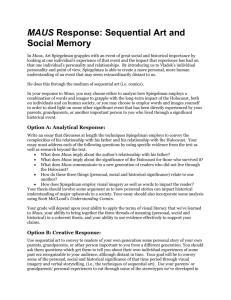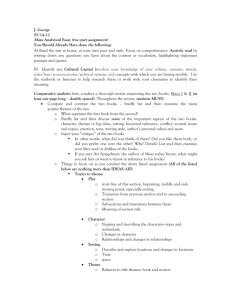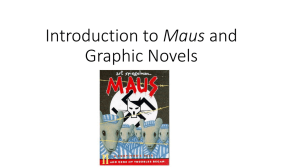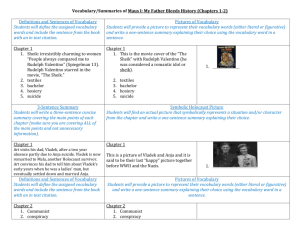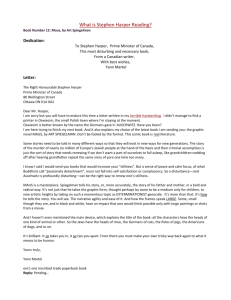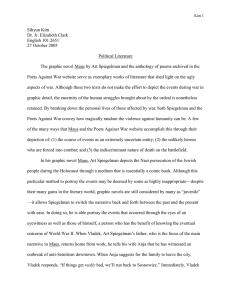MAUS
advertisement
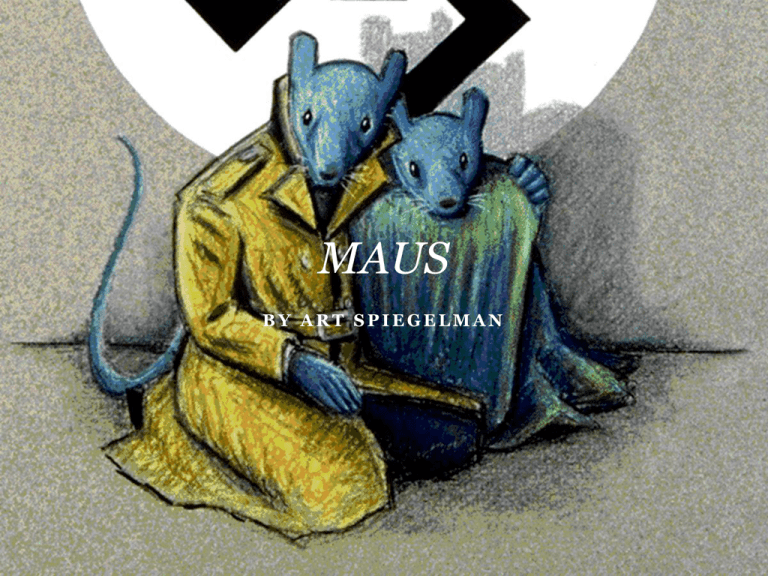
MAUS BY ART SPIEGELMAN Art Spiegelman Art Spiegelman Born 15 February 1948 in Stockholm, Sweden American cartoonist and comics advocate based in NYC Published Maus in two parts, 1986 and 1991 Maus won the Pulitzer Prize “In the Shadow of No Towers” was his graphic novel about September 11th Appeared in a 2007 episode of The Simpsons as himself Maus Completed in 1991 Depicts Art Spiegelman interviewing his father, Vladek, about his experiences as a Polish Jew and Holocaust survivor Uses different animals to portray a variety of races Much of the story revolves around Spiegelman’s troubled relationship with his father Inner-story – Vladek’s experiences during the Holocaust in the 1930s and 1940s Outer-story – Art interviewing and interacting with Vladek throughout the 1970s and early 1980s Comic Form Most of Maus has traditional comic book movement (horizontal). The panels read from left to right across a page and then go down (Page 11 is an example of that) Occasionally though, Spiegelman uses non-traditional arrangements of panels that move from outer to inner, top to bottom, etc Page 61 is an example of this While reading, make sure to track similarity of composition, repetition of objects/characters, relative size of panels, presence/absence of frames, etc Comic Form Comic Form Comic format manipulates reading speed in a way that books struggle to Complex visuals force readers to slow down Panels that are very “busy” tend to be extremely important Take your time and slow down when the artist is giving you clues that you really need to be paying attention Seeing what the artist sees Fractured Narrative/Unreliable The inner and outer story is very, very important. You need to learn to recognize who is speaking and when Spiegelman will move back and forth between the two timelines Must track visual clues to stay aware of when/where we are Unreliable Narrator Vladek forgets things, acts differently in the two different timelines, etc Visual Metaphors Any visual symbol or picture that is used to represent something else. Visual Metaphors are often used in political cartoons. Characters Maus I Jewish people are represented by mice. The Germans are represented by cats. The Americans are represented by dogs. Polish people are represented by pigs. Maus II The Roma (Gypsies) are represented as gypsy moths. The British are represented by fish. The child of a Jew and a German is shown as a mouse with cat stripes. Characters What do you think is the significance of using these different animals to represent the different groups? Why do you think Spiegelman used animals for symbols rather than drawing humans? Characters Characters Characters Controversy "[A Polish press attaché] said, 'Do you realize that it is a terrible insult to call a Pole a pig? It's worse than it even sounds in English. Do you realize that the Germans called us schwein [pigs]?' Art’s Response So I said, 'Yeah, and the Germans called us vermin. These aren't my metaphors. These are Hitler's.' And that gave us common ground. I pointed out that, in the book, there are Jews who act admirably-but there are many Jews in the book who don't. These are just people wearing masks. And the same is true of the Poles. There are some Poles who saved my parents' lives and who were very kind, and there were some who were swine." "The Jews are undoubtedly a race, but they are not human.” –Hitler This quote is written on the copyright page of Maus, why do you think the author placed it there? Big Ideas to Watch Out For Anja as a non-character. Vladek’s first wife/Art’s mother. She is a “glaring void” throughout Maus. A black hole of a character. She’s there…but not really. Draws our attention, but we never really see/know her. Contrast between Old/Young Vladeks. Why the difference? Vladek is unreliable as a narrator Vladek is changed by the Holocaust Vladek has aged ungracefully Conflicting Loyalties – Characters are often forced to choose between their own survival and those near to them Big Ideas to Watch Out For Use of English – Vladek is the only person who speaks with an accent in the outer story. Even the other Holocaust survivors speak “Normal” English In inner story, Vladek’s knowledge of English often helps him survive Memory – Much like Night, Maus is a book about memory and the importance of memorializing the Holocaust
